Road Safety
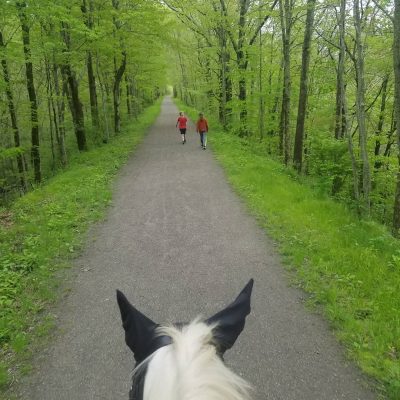
You must respect signs and other users when you are on roads.
Please:
- Observe all traffic directions
- Ride on the right side of the road
- People should walk facing traffic
- Stop at stop signs
- Signal turns if there is someone behind you
- Ride single file when sharing roads or trails
- Carry a light visible at least 200 ft to front and rear
- All riders should cross the road about the same time
- Wear reflective clothing
Trail etiquette
On the trail, courtesy is a necessity.
If you ride a horse, you have priority but should observe caution because not all trail users will be aware of this.
The more we strive to apply common sense rules of courtesy and etiquette, the better the chances of a safe and stress-free ride.
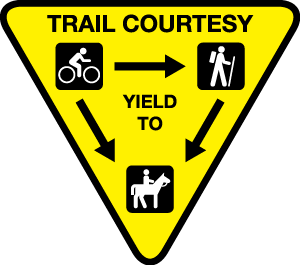
https://www.fs.usda.gov/detail/btnf/recreation/?cid=fseprd509212
Always wear a helmet!
Before going on the trail check your helmet. It must be replaced every 5 years or if it has cushioned you in a fall. Wear it for every ride even if you have known your horse for many years. Falls happen fast and unexpectedly!
Rules for a good trail
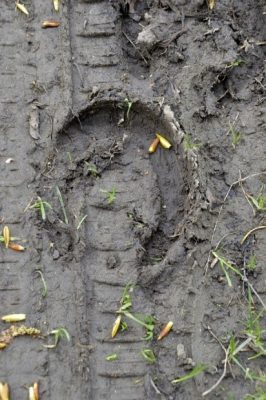
Travel on Durable Surfaces1,2
Be aware of mud and avoid causing ruts. Don’t exacerbate the situation by developing parallel “herd” trails in order to avoid unsafe, deeply incised or boggy segments. It could result in widespread erosion problems.
Indeed, too many users or horses can damage a wilderness area or trail. Riding too fast on wet soil destroys footing. Repeated shortcuts across switchbacks cause erosion that creates deep gullies. Crossing streams at random points pushes silt into the water. Off-trail riding in fragile ecosystems damages plants that may take years to recover.
Obey all local rules designed to protect sensitive areas.

Dispose of Waste Properly
When going out on the trail, please do not litter. If you generate waste while riding, keep it with you until you find a trash can or carry it out. Some trails make bins available. Try to use them properly. Carry in carry out. Consider bringing a bag with you for garbage.
Leave What You Find
Do not pick flowers or plants, leave them for others to enjoy!
Respect Wildlife

Do not feed wild animals – it’s generally not good for their health and for their natural behavior.
Protect your food and your waste from animals.
Limit noise and sudden movements.
Watch animals from a distance, and do not try to approach them. If you cause changes in an animal’s behavior, you are too close.
Be Considerate of Other Users1
Respect for other horsemen includes basic etiquette such as slowing to a walk as you approach or leave other horses, always keeping your horse secure, and letting others know if your horse tends to kick by putting a red ribbon in its tail.
Courtesy for other recreationists is even more crucial. Keep your distance from the crowds as much as possible. You are likely to encounter people who don’t know how to behave around horses. Always be polite.
Do not cross fields, pastures or crops. This could damage the land and cause conflicts with farmers.
Manure is biodegradable
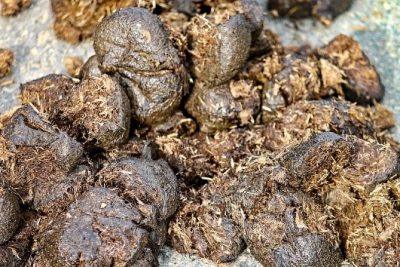 Horse manure is free of microorganisms that infect humans. Parasites that infect horses are not dangerous for humans. Parasites that infect horses are not dangerous to humans. There is no Cryptosporidium or Giardia in horse manure.
Horse manure is free of microorganisms that infect humans. Parasites that infect horses are not dangerous for humans. Parasites that infect horses are not dangerous to humans. There is no Cryptosporidium or Giardia in horse manure.
Up to 80% of the water in the manure is evaporated or infiltrated in the soil, the rest is undigested parts of plants.
EPA excludes manure from solid waste regulations because it does not contain hazardous chemicals and has no hazardous characteristics.
Bees and flies
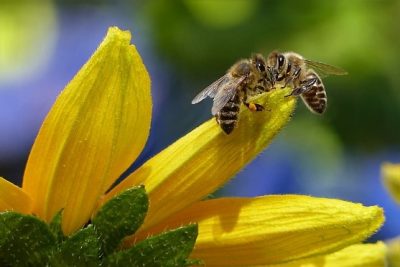 Bees are usually found on the trail from summer to fall with the most dangerous encounters usually from August through September in Connecticut. Bees sting when they feel threatened: it’s their way of defending themselves. During a sting, the sting is usually removed from the bee and remains planted in the skin, causing the death of the bee Unlike bees, wasps can sting without any real reason Their sting is firmly attached to their body, which allows them to sting several times.
Bees are usually found on the trail from summer to fall with the most dangerous encounters usually from August through September in Connecticut. Bees sting when they feel threatened: it’s their way of defending themselves. During a sting, the sting is usually removed from the bee and remains planted in the skin, causing the death of the bee Unlike bees, wasps can sting without any real reason Their sting is firmly attached to their body, which allows them to sting several times.
To avoid getting bitten, follow these tips:
- Avoid any sudden or rapid movement
- Odors, perfumes and other cosmetics attract insects so avoid using them when you go in the wild
Furthermore, protect your horse(s) from flies with fly spray and a bonnet! They can be very disturbing while trail riding!

Bridge safety
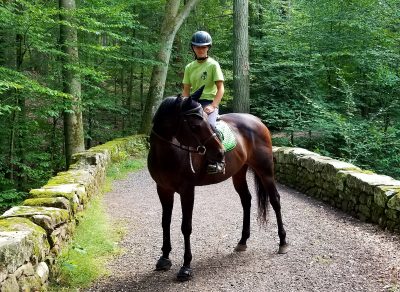
In general, it is better not to ride your horse through water but utilize an established water crossing or bridge whenever possible. Riding in water bodies may destroy aquatic life.
A bridge must be carefully analyzed before asking your horse to cross it. It may be old or obsolete and it can potentially collapse under the weight of the horse.
In addition, horses may be reluctant to cross if the bridge is narrow, swings, vibrates, is built with unknown materials, or amplifies noise.
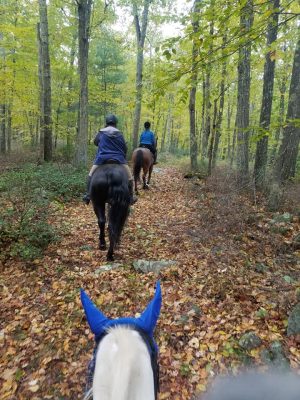
Sight line
You must be able to see clearly ahead of you before go faster. You do not want to accidentally run into other users.
Also, help your horse when the going is difficult. A horse new to the trail or even one often used in the arena may need guidance in areas with tricky or rocky footing. Remember to give your horse its head over rough sections.
Lighting
Choose trails where you have good visibility. Always bring a flashlight just in case. Most rescues occur when a person did not expect to be out after dark and did not bring a flashlight. To preserve night vision and avoid blinding other users, use a flashlight that has a red light feature when you are in an area with other users.
Bring phone
It is strongly recommended that everyone on the trail is equipped with a mobile phone. Thus, in case of emergency, it is possible to call for help or simply to contact someone if necessary. Do not leave the phone on your horse, keep it on your person either through a pouch or some sort of fastening. However, you should not rely on that as your only source of help. Leave an itinerary with someone not with you in case your cell phone battery goes dead.
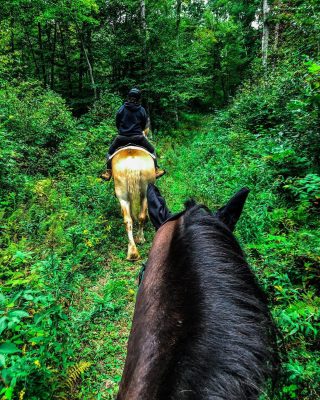
Try to avoid going alone2
Horse people tend to be an individualistic and independent lot, but even the most experienced rider can get hurt on a trail. It’s worth riding with a companion or two. You will be safer and relaxed, just like your horse.
Also, when you leave home, be sure to tell someone when to expect you back and where you might be if you are not back by that time. The sooner someone knows to look for you, the better.
Contact info
Dr Jenifer Nadeau, Associate Professor, Equine Extension Specialist, University of Connecticut
Camille Guérineau, graduate student and summer intern
camille.guerineau@agrosupdijon.fr
This document was created during the internship of Camille Guérineau from AgroSup Dijon from April to August, 2019 at the University of Connecticut’s Department of Animal Science under the supervision of Dr. Jenifer Nadeau, Equine Extension Specialist and Associate Professor. We would like to sincerely thank the involvement of many of those involved with the CT horse industry who provided input and photos to make this possible as well as Laura Brown, chair of the PATHS Team and Community & Economic Development Educator with Uconn Extension and Certified Economic Developer (CEcD). Also thanks to the other PATHS Team members for their help and support.
We also thank Michelle Lewis, Cynthia Chotkowski, Kristen Govoni, Jen Otis, Peter von Halem, Charlotte Gelston, Anne Zagryn and Steven Mazeau for having contributed to the creation of these web pages by providing us with their photos.
References
1EQUUS 356, May 2007,p 77 – 85, Take the trail rider’s Pledge by Gene Wood, PhD, with Laurie Bonner, consulted 05/23/2019
2 Environmental Impacts Associated with Recreational Horse-riding, David Newsome, David N. Cole and Jeffrey L. Marion, consulted 05/23/2019 http://winapps.umt.edu/winapps/media2/leopold/pubs/517.pdf
Photography from Pixabay